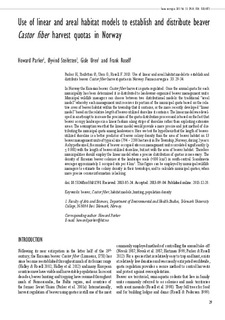| dc.contributor.author | Parker, Howard | |
| dc.contributor.author | Steifetten, Øyvind | |
| dc.contributor.author | Uren, Gisle | |
| dc.contributor.author | Rosell, Frank | |
| dc.date.accessioned | 2016-11-05T22:24:58Z | |
| dc.date.accessioned | 2017-04-19T12:24:34Z | |
| dc.date.available | 2016-11-05T22:24:58Z | |
| dc.date.available | 2017-04-19T12:24:34Z | |
| dc.date.issued | 2013 | |
| dc.identifier.citation | Parker, H., Ø. Steifetten, G. Uren, & Rosell, F. Use of linear and areal habitat models to establish and distribute beaver Castor fiber harvest quotas in Norway. Fauna Norvegica 33(2013), p. 29-34 | |
| dc.identifier.issn | 1891-5396 | |
| dc.identifier.uri | http://hdl.handle.net/11250/2437957 | |
| dc.description.abstract | In Norway the Eurasian beaver Castor fiber harvest is quota-regulated. Once the annual quota for each municipality has been determined it is distributed to landowner-organized beaver management units. Municipal wildlife managers can choose between two distributional models: the traditional “areal model” whereby each management unit receives its portion of the municipal quota based on the relative area of beaver habitat within the township that it contains, or the more recently developed “linear model” based on the relative length of beaver-utilized shoreline it contains. The linear model was developed in an attempt to increase the precision of the quota distribution process and is based on the fact that beaver occupy landscapes in a linear fashion along strips of shoreline rather than exploiting extensive areas. The assumption was that the linear model would provide a more precise and just method of distributing the municipal quota among landowners. Here we test the hypothesis that the length of beaverutilized shoreline is a better predictor of beaver colony density than the area of beaver habitat on 13 beaver management units of typical size (794 – 2200 hectares) in Bø Township, Norway, during 2 years. As hypothesized, the number of beaver occupied sites on management units correlated significantly (p≤ 0.001) with the length of beaver-utilized shoreline, but not with the area of beaver habitat. Therefore municipalities should employ the linear model when a precise distribution of quotas is necessary. The density of Eurasian beaver colonies at the landscape scale (>100 km2) in south-central Scandinavia averages approximately 1 occupied site per 4 km2. This figure can be employed by municipal wildlife managers to estimate the colony density in their townships, and to calculate municipal quotas, when more precise census information is lacking. | |
| dc.language.iso | eng | |
| dc.publisher | Norwegian University of Science and Technology (NTNU), University Museum | |
| dc.rights.uri | http://creativecommons.org/licenses/by-nc/4.0/ | |
| dc.subject | mammalia | |
| dc.subject | beaver | |
| dc.subject | habitat models | |
| dc.subject | hunting | |
| dc.subject | population density | |
| dc.title | Use of linear and areal habitat models to establish and distribute beaver Castor fiber harvest quotas in Norway | |
| dc.type | Journal article | |
| dc.type | Peer reviewed | |
| dc.description.version | Published version | |
| dc.rights.holder | Copyright The Authors | |
| dc.subject.nsi | 480 | |
| dc.source.journal | Fauna Norvegica | |
| dc.identifier.doi | http://dx.doi.org/10.5324/fn.v33i0.1591 | |

